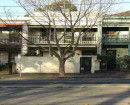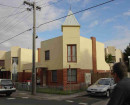SHOPS
195 ELIZABETH STREET MELBOURNE, MELBOURNE CITY
-
Add to tour
You must log in to do that.
-
Share
-
Shortlist place
You must log in to do that.
- Download report
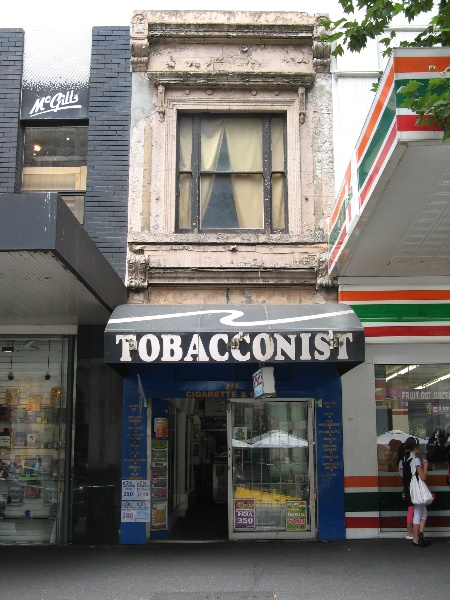

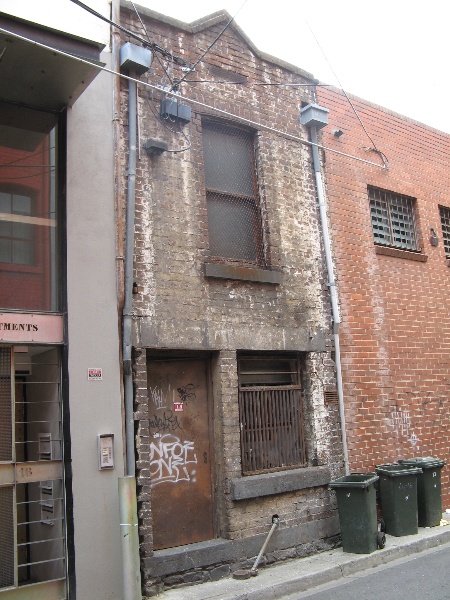
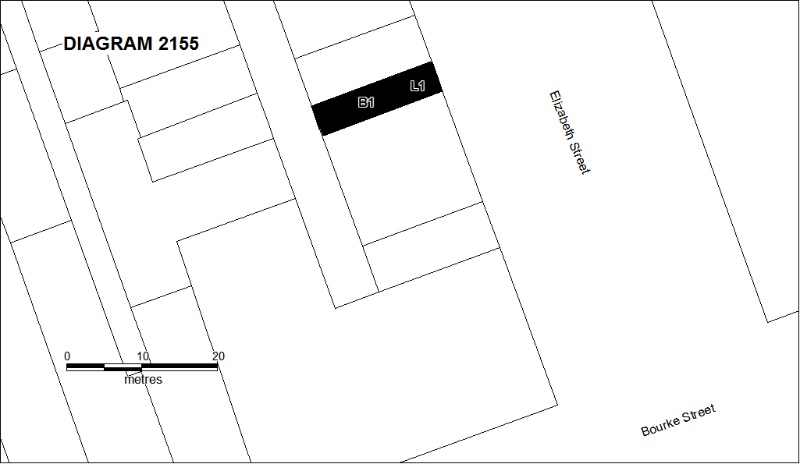
Statement of Significance
What is significant?
The shop at 195 Elizabeth Street was probably built in 1853, in a prominent position opposite the Melbourne Post Office. Elizabeth Street was the beginning of the road to the goldfields, and in the early 1850s was the preferred location for the town's gold brokers. The shop was used from 1853 to 1854 as a gold broker's office run by M Simmons, after which it had various uses: as premises successively for a clothier, a boot-maker, a hairdresser and then a draper. For over forty years from 1867 until 1910 it operated as an oyster saloon, a type of restaurant common in the nineteenth and early twentieth centuries and frequented mainly by the less well-off, as oysters were then very cheap. In the 1880s there were at least sixty oyster saloons in the city. They could be established by those with little capital, Greek immigrants in particular being commonly associated with oyster saloons, and in the 1880s Greeks ran the oyster saloon at 195 Elizabeth Street. From 1912 to 1951 the shop was used as a hairdresser and tobacconist, and since then has continued to operate as a tobacconist.
The shop occupies a long narrow site only about three metres wide. It is a two storey brick building on bluestone footings. The front facade is rendered, with a modern shopfront on the ground floor, but intact on the first floor. Above the modern cantilevered verandah is a string course and remnants of the original verandah flashing, with decorative consoles at each end. The single wide window on the first floor has triple double hung sashes, a moulded architrave and a hood mould. The cornice above is similar to the verandah level string course, also with the decorative consoles at each end. The rear elevation is of brick and bluestone, with remnants of old paint finishes; the exposed base wall is of bluestone rubble construction; the window sills are of dressed bluestone; and there is a dressed bluestone lintel extending the full width of the building over the ground floor openings. In front of the ground floor rear window are iron bars, probably dating from the nineteenth century. The roof has been replaced. Internally, on the ground floor is the long narrow shop area at the front, from which a thick solid timber door and bluestone steps lead to a smaller room at the rear, which includes a later toilet. A timber staircase, with turned balusters and newel posts decorated with mirrors, leads to the first floor. Upstairs are what were once the living quarters, also of two rooms: a long room at the front, probably originally the living room, and a smaller room, probably a bedroom, at the rear. What was once a timber-lined lantern light above the stairs at the rear of the front room has metal bars beneath, and is now covered by the new roof.
How is it significant?
The shop at 195 Elizabeth Street is of historical and architectural significance to the state of Victoria.
Why is it significant?
The shop at 195 Elizabeth Street is of historical significance as one of the oldest surviving shops in Victoria. It is significant for its use in the early 1850s as a gold broker's office, located on what was then the main route to and from the goldfields. It is significant for its use for forty years in the late nineteenth and early twentieth centuries as an oyster saloon, an early type of restaurant which has now disappeared; these were patronised by the less well-off, and were the forerunner of modern cafes. It is also significant for its association with early Greek immigration to Victoria. It is significant as an unusual surviving example of the small shops with residences above which were once common in the city, and of the small building sites in the central business district which have progressively disappeared during the twentieth century as they have become amalgamated into larger blocks. Its narrow frontage reflects the lack of building regulations and the diverse nature of land use in Melbourne in its early years.
The shop at 195 Elizabeth Street is of architectural significance as a now rare example of a modest shop of the 1850s with a residence above.
-
-
SHOPS - History
CONTEXTUAL HISTORY
The land along Elizabeth Street was included in one of Melbourne's first land sales in November 1837, and despite it being a creek course and liable to flooding, the street became one of the major streets of the new town, and a major focus of the town's retail activity. Following the discovery of gold, it became the main route from Melbourne to and from the goldfields. It also became the preferred location for Melbourne's gold brokers: in 1853 eighteen of the thirty-two gold brokers listed in Melbourne were located in Elizabeth Street (The New Quarterly Melbourne Directory, 1853).
The early gold rush period was a time of rapid development and of great change in the city of Melbourne, and there were great opportunities for importers and merchants. At first the city was drained of labour and building virtually ceased: only forty-one buildings were put up in the centre of Melbourne between the first quarter of 1852 and that of 1853, but in 1853 the building industry began to normalise, and 1027 buildings were put up in the first half of the year. Between 1853 and 1854 the total number of buildings in Melbourne doubled, though buildings materials remained scarce until about September 1853. (Lewis, Melbourne, p 53).
Oysters were a popular food for all classes in colonial Australia, and oyster saloons were established in Melbourne from at least the 1840s. Oysters had been regarded as food for the poor in eighteenth century England, and were praised for their medicinal value, their cheapness and their ready availability, being free for the gathering along the coast. For centuries oysters were so cheap in London that even the very poor could afford them; they might even be said to be associated with poverty. Oyster bars featured as part of the English urban landscape and were the setting for events involving the lower classes in for example the novels of Dickens. In The Pickwick Papers (1837) Sam Weller describes Whitechapel: '. here's a oyster stall to every half dozen houses. The Street's lined vith 'em. Blessed if I don't think that ven a man's very poor, he rushes out of his lodgings, and eats oysters in reg'lar desperation'. Oyster bars also appear as a setting for action in chapter 27 of The Life and Adventures of Martin Chuzzlewit and chapter 39 of the Old Curiosity Shop. Due to urban growth and dredging in London in the mid nineteenth century, oysters became less readily available, but this was not the case in Australia (Symons, One Continuous Picnic, p 23). Oysters were not only enjoyed by the poor: they were served to Prince Alfred during his visit to Sydney in 1867 (Symons p 57).
Oysters were sold in great quantities at Melbourne's markets, by street hawkers and at oyster stalls in the streets. They were very cheap: in September 1849 they were selling for six shillings a bucketful or about three pence a dozen (Annear, Bearbrass, p 183). Later sixteen freshly-opened oysters with salt and pepper could be bought at oyster stalls in the streets for sixpence (Cannon, Life in the Cities, p 36).
Among the earliest restaurants in Australia were those of all classes which sprang up in Melbourne after the gold rushes. At the bottom of the scale were four-penny and six-penny restaurants, and the oyster saloons, frequented by the less well off (Cannon, Life in the Cities, p 36). The wealthier were more likely to dine at their clubs than in restaurants. Oyster saloons became common in the nineteenth and early twentieth centuries. They were the forerunners of modern cafes (National Museum of Australia, 1 January - 30 June 2007, 'Australian Journeys. Continental Migration before World War II. Greek Oyster Saloons and Cafes Exhibition') and were important local meeting places for the working classes. Frank Fowler in Southern Lights and Shadows (London 1858) notes that there were 'scores' of oyster saloons in Melbourne; Blayney (Black Kettle Full Moon, p 304) notes that in 1888 there were at least sixty. According to Fowler, 'As in London, they are to be found with private boxes, red-curtained - in the neighbourhood of the theatres'. When the bushranger George Melville was hanged in Melbourne in 1853 his widow, who owned an oyster shop in Collins Street, displayed his body, lying on ice and decorated with flowers, in the window of her shop, which did wonders for trade.
Oyster saloons were a business that could be started by those with little capital. Henry Lawson referred to this in his poem 'The Men who come behind':
If you save a bit of money, and you start a little store -
Say, an oyster shop, for instance, where there wasn't one before -
Immigrants, particularly those from Greece, often opened oyster saloons as a means of establishing themselves in Australia. Greeks have been in Victoria since the Gold rush of the 1850s: they were amongst the sailors who left their English ships when they heard the discovery of gold. Most intended to return home rich men, so few women came to join them. By 1871, there were only nineteen Greece-born women in Victoria, and 127 men. After the gold declined, those who stayed found work in restaurants, cafes and shops, and their numbers increased as they were joined by relatives and friends from Greece. The first wave of Greek immigrants came in the later part of the nineteenth Century. The first Greek cafes in Australia can often be traced back to the oyster bars they ran in the late nineteenth century.
The oyster saloons began to disappear before World War I, as the oyster beds became exhausted and the oyster price began to rise.
HISTORY OF PLACE
[The shop at 195 Elizabeth Street is noted in some studies to have been built during the pre-gold rush period, but no evidence is given for this. The Australian Heritage Database states that it appears to have been occupied by Isaac Booth, whose store traded as Manchester House, a general drapery and silk store. Booth is known of because in the 1850s he was one of the sixty-one Victorian traders to issue their own trade tokens in lieu of currency, which was then in short supply. However, according to the Australian Storekeepers and Traders Journal (12 December 1910), from 1851-55 Booth's shop was at 129 Elizabeth Street (south of the hotel then called the Bakers Arms, later the Glasgow Arms). This became no 189 following the change of street numbers in Elizabeth Street in 1889. The shop at 195 Elizabeth Street was immediately north of the hotel, and under the old numbering system is listed in the Directories as 133½ or 133A Elizabeth Street.]
The shop now at 195 Elizabeth Street does not seem to have been present in 1851, and first appears in the Melbourne Directories in 1853, occupied by M Simmons, a gold broker. The 1853 New Quarterly Melbourne Directory lists:
number 129: Isaac Booth, draper;
number 131: R & J Clowes, ironmongers;
Bakers Arms hotel (no street number);
number 133 (now no 195): M Simmons, goldbroker;
number 135: G Taylor, bootmaker.
Simmons' gold brokers shop is most likely the present shop at 195 Elizabeth Street, between the hotel (listed here without a number, but listed in later directories as number 133, with the shop to the north (now no 195) appearing as 133A or 133½). The gold broker's shop may have been constructed on land at first left vacant on the north side of the block when the hotel was built (before 1851). It was a prosperous period, at the beginning of the gold rushes, and this was a prime location, opposite the Post Office and on the road to the diggings, so the land would have been expensive and in demand as a commercial site. It would appear that the shop was built on this bit of vacant land, which was not a full-sized building block, but simply a narrow strip of vacant land between the hotel and shop to the north. This would account for the unusually narrow shop, probably now the narrowest in the city.
The Directories show that by 1855 the subject shop is occupied by a W E Milnes, (1855-6), then by Alex Lyons, a clothier (1857-60), J Cohen, clothier (1861), J Coutie, bootmaker (1863), A Laroome, hairdresser (1864-5), and N Solomon, draper (1865). It appears to have been unoccupied in 1866, but from 1867 it begins a long period of use as an oyster saloon, which continues until 1910. The oyster saloon was first operated by Nicholas Sarton; then from 1868 until 1892 by David Kirk; in 1893 by David Paxenos (presumably of Greek origin); in 1894-1908 by Coney Raftopoulos (another Greek); and in 1910-10 by the Christie brothers. The operation of the oyster bar by Greek immigrants reflects the common involvement of Greek immigrants in the late nineteenth and early twentieth centuries in fish and oyster shops (later milk bars and cafes). In the 1911 Directory the shop is listed as 'Dining Rooms', but thereafter became a Hairdresser and Tobacconist, run in 1912-27 by Panayottie Lucas, and 1928-1951 by A J Peel. Since 1952 it has been a Tobacconist.
SHOPS - Assessment Against Criteria
a. The historical importance, association with or relationship to Victoria's history of the place or object
The shop at 195 Elizabeth Street is one of the oldest surviving shops in Victoria. It is important for its original use in the early 1850s as a gold broker's office, located on what was then the main route to and from the goldfields. For forty years in the late nineteenth and early twentieth centuries it was an oyster saloon, an early type of restaurant which has now disappeared; these were patronised by the less well-off, and were the forerunner of modern cafes. It is also associated with early Greek immigration to Victoria.
b. The importance of a place or object in demonstrating rarity or uniqueness
The shop is an unusual surviving example of the small shops with residences above which were once common in the city, and of the small building sites in the central business district which have progressively disappeared during the twentieth century as they have become amalgamated into larger blocks. It is significant for its very narrow frontage, reflecting the lack of building regulations and the diverse nature of land use in Melbourne in its early years.
c. The place or object's potential to educate, illustrate or provide further scientific investigation in relation to Victoria's cultural heritage
d. The importance of a place or object in exhibiting the principal characteristics or the representative nature of a place or object as part of a class or type of places or objects
The shop is typical of the small shops with a residence above which were once common in the city.
e. The importance of the place or object in exhibiting good design or aesthetic characteristics and/or in exhibiting a richness, diversity or unusual integration of features
f. The importance of the place or object in demonstrating or being associated with scientific or technical innovations or achievements
g. The importance of the place or object in demonstrating social or cultural associations
The shop is important for its association with early Greek immigration to Victoria.
h. Any other matter which the Council deems relevant to the determination of cultural heritage significance
a. The historical importance, association with or relationship to Victoria's history of the place or object
The shop at 195 Elizabeth Street is one of the oldest surviving shops in Victoria. It is important for its age and for its use in the early 1850s as a gold broker's office, located on what was then the main route to and from the goldfields. For forty years in the late nineteenth and early twentieth centuries it was an oyster saloon, an early type of small restaurant which was common until World War I but which has now disappeared. These were patronised by the less well-off, and are considered to have been the forerunner of the modern cafe. The shop is also associated with Greek immigration to Victoria in the nineteenth century.
b. The importance of a place or object in demonstrating rarity or uniqueness
The shop at 195 Elizabeth Street is unusual for its age, as buildings associated with this early phase of the gold rushes in Victoria are now uncommon. The shop is also important as an unusual surviving example of the small shops with residences above which were once common in the city, and of the small building sites in the central business district which have progressively disappeared during the twentieth century as they have become amalgamated into larger blocks. It is significant for its very narrow frontage, reflecting the lack of building regulations and the diverse nature of land use in Melbourne in its early years.
c. The place or object's potential to educate, illustrate or provide further scientific investigation in relation to Victoria's cultural heritage
d. The importance of a place or object in exhibiting the principal characteristics or the representative nature of a place or object as part of a class or type of places or objects
The shop is typical of the small shops with a residence above which were once common in the city.
e. The importance of the place or object in exhibiting good design or aesthetic characteristics and/or in exhibiting a richness, diversity or unusual integration of features
f. The importance of the place or object in demonstrating or being associated with scientific or technical innovations or achievements
g. The importance of the place or object in demonstrating social or cultural associations
The shop is important for its association with Greek immigration to Victoria in the nineteenth century, well before the great wave of Greek immigration in the twentieth century, which is more widely known.
h. Any other matter which the Council deems relevant to the determination of cultural heritage significance
SHOPS - Plaque Citation
This shop is one of the oldest in Victoria. It was on the main road to the goldfields and from 1853-1854 was used as a gold broker's office. From 1867-1910 it was an oyster saloon.
SHOPS - Permit Exemptions
General Exemptions:General exemptions apply to all places and objects included in the Victorian Heritage Register (VHR). General exemptions have been designed to allow everyday activities, maintenance and changes to your property, which don’t harm its cultural heritage significance, to proceed without the need to obtain approvals under the Heritage Act 2017.Places of worship: In some circumstances, you can alter a place of worship to accommodate religious practices without a permit, but you must notify the Executive Director of Heritage Victoria before you start the works or activities at least 20 business days before the works or activities are to commence.Subdivision/consolidation: Permit exemptions exist for some subdivisions and consolidations. If the subdivision or consolidation is in accordance with a planning permit granted under Part 4 of the Planning and Environment Act 1987 and the application for the planning permit was referred to the Executive Director of Heritage Victoria as a determining referral authority, a permit is not required.Specific exemptions may also apply to your registered place or object. If applicable, these are listed below. Specific exemptions are tailored to the conservation and management needs of an individual registered place or object and set out works and activities that are exempt from the requirements of a permit. Specific exemptions prevail if they conflict with general exemptions. Find out more about heritage permit exemptions here.Specific Exemptions:General Conditions: 1. All exempted alterations are to be planned and carried out in a manner which prevents damage to the fabric of the registered place or object. General Conditions: 2. Should it become apparent during further inspection or the carrying out of works that original or previously hidden or inaccessible details of the place or object are revealed which relate to the significance of the place or object, then the exemption covering such works shall cease and Heritage Victoria shall be notified as soon as possible. Note: All archaeological places have the potential to contain significant sub-surface artefacts and other remains. In most cases it will be necessary to obtain approval from the Executive Director, Heritage Victoria before the undertaking any works that have a significant sub-surface component. General Conditions: 3. If there is a conservation policy and plan endorsed by the Executive Director, all works shall be in accordance with it. Note: The existence of a Conservation Management Plan or a Heritage Action Plan endorsed by the Executive Director, Heritage Victoria provides guidance for the management of the heritage values associated with the site. It may not be necessary to obtain a heritage permit for certain works specified in the management plan. General Conditions: 4. Nothing in this determination prevents the Executive Director from amending or rescinding all or any of the permit exemptions. General Conditions: 5. Nothing in this determination exempts owners or their agents from the responsibility to seek relevant planning or building permits from the responsible authorities where applicable. Minor Works : Note: Any Minor Works that in the opinion of the Executive Director will not adversely affect the heritage significance of the place may be exempt from the permit requirements of the Heritage Act. A person proposing to undertake minor works may submit a proposal to the Executive Director. If the Executive Director is satisfied that the proposed works will not adversely affect the heritage values of the site, the applicant may be exempted from the requirement to obtain a heritage permit. If an applicant is uncertain whether a heritage permit is required, it is recommended that the permits co-ordinator be contacted.SHOPS - Permit Exemption Policy
The purpose of the Permit Policy is to assist when considering or making decisions regarding works to the place. It is recommended that any proposed works be discussed with an officer of Heritage Victoria prior to them being undertaken or a permit is applied for. Discussing any proposed works will assist in answering any questions the owner may have and aid any decisions regarding works to the place. It is recommended that a Conservation Management Plan is undertaken to assist with the future management of the cultural significance of the place.
The extent of registration protects the whole site. The significance of the place lies in its rarity and intactness as a very early shop with a residence above. All of the registered building is integral to the significance of the place and any external or internal alterations that impact on its significance are subject to permit application.
-
-
-
-
-
FORMER CARLTON AND UNITED BREWERY
 Victorian Heritage Register H0024
Victorian Heritage Register H0024 -
ROSAVILLE
 Victorian Heritage Register H0408
Victorian Heritage Register H0408 -
MEDLEY HALL
 Victorian Heritage Register H0409
Victorian Heritage Register H0409
-
..esterville
 Yarra City
Yarra City -
1 Alfred Crescent
 Yarra City
Yarra City -
1 Barkly Street
 Yarra City
Yarra City
-
-







